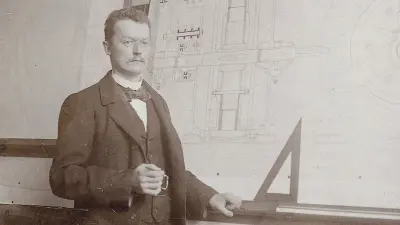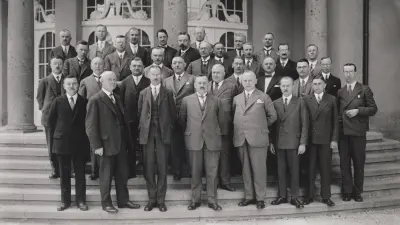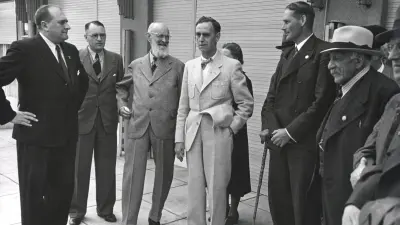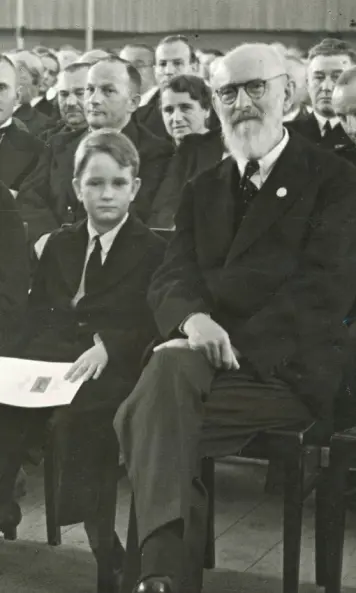From Vermögensverwaltung Bosch to Robert Bosch Stiftung
An institution celebrates a century

Robert Bosch set up Vermögensverwaltung Bosch GmbH in 1921. In the entity’s guidelines, he stated a few clear objectives: “Apart from the alleviation of all kinds of hardship, support should be given to promote health, education, programs to help the gifted, international reconciliation, and similar objectives.” The aim in doing so was to make sure that Bosch’s charitable efforts would continue after his death. In 1964, Vermögensverwaltung Bosch — which would be renamed Robert Bosch Stiftung GmbH in 1969 — was restructured to ensure its independence for the future.
Certainty for the future

For years, the future of the company had been on Bosch’s mind. His only son was incurably ill with multiple sclerosis, leaving him poorly equipped to take over the business. Bosch’s implicitly designated successor, the director of sales Gustav Klein, had been killed during a test flight with new type of aircraft in 1917, and Bosch himself was in poor health at the time.
Despite having been able to imagine selling the business in his earlier years, the survival of his company had since become a key issue and mission. For a while, Bosch had been thinking of giving his closest and most trusted associates a stake in the company, thus allowing them to share part of the responsibility. What is more, Gustav Klein and his colleagues had repeatedly pushed Bosch to let them acquire a share of the company. It was clear that the previous legal form of a sole proprietorship had to change for that to happen.
Establishment and mission

On the advice of his friend and lawyer Paul Scheuing, Bosch transformed his company into a public limited company (stock corporation) in December 1917. Bosch’s closest associates were made partners, receiving 49 percent of the shares in the company. Bosch himself held 51 percent, of which he granted trusteeship of two percentage points to Scheuing.
A solution also had to be found for Robert Bosch’s personal assets. Hans Walz, his private secretary, cooperated with Scheuing to work out the basis for a charitable approach to asset management. According to the plans, Bosch’s shares of the stock corporation would be transferred to Vermögensverwaltung Bosch, where it would form the capital base for the company’s charitable support projects after his death.
Following the establishment of Vermögensverwaltung GmbH on March 9, 1921, Bosch outlined its mission: “Vermögensverwaltung Bosch GmbH […] has been set up by me to […] manage my entire assets and my business and social undertakings.” The purpose was to give Bosch’s charitable activities a solid foundation and long-term financial support. Moreover, his successors were charged with the task of continuing to run the company in accordance with the principles and wishes of its founder. The structure was also designed to prevent quarreling or poorly suited heirs from damaging the company.
Bosch’s endowments and charitable initiatives over the years that followed were so wide-ranging that it is only possible to mention a few examples here, such as building the Robert Bosch Hospital in Stuttgart, constructing the Neckar Canal, and funding various universities.

The circumstances change
Robert Bosch’s personal circumstances changed, and his will needed to be adapted accordingly. After the death of his first-born son in 1921, a second marriage gave him another son as a potential successor at the company in 1928.
A will and a new company structure were drawn up to take these new circumstances into account. At the same time, additional room for interpretation was necessary to enable a high degree of flexibility and the necessary adjustments to changed circumstances going forward. Over a period of years, Bosch and his partners, working as a group of executors, developed a structure for a corporate constitution that would place maintaining the company’s competitiveness on an equal footing with corporate citizenship. In the end, three documents would form the basis for future actions: the will, the guidelines, and the corporate constitution.
Bosch, who died in 1942 at the age of 80, transferred responsibility for making sure that the company would be carried on after his death in a manner reflective of his wishes to his group of executors.
In 1964, fundamental changes were made following a drawn-out conflict over how to interpret Robert Bosch’s will, giving Robert Bosch GmbH and Vermögensverwaltung Bosch a new structure: In keeping with the intent of Robert Bosch’s wishes, charitable and economic interests were awarded equal status in the new constitution. Neither of the interests were to impede or override the other.
Not without sacrifice, Robert Bosch’s heirs transferred their shares to Vermögensverwaltung GmbH. In return, Vermögensverwaltung Bosch waived the voting rights from these shares. The voting rights were transferred to a trust set up especially for this purpose. Known today as Robert Bosch Industrie Treuhand KG, its purpose is to exercise the owners’ rights in dealings with Robert Bosch GmbH.
Vermögensverwaltung Bosch — which would not change its name to Robert Bosch Stiftung GmbH until 1969 — thus had a solid financial basis that was viable for the future. The result was a permanent link and equal balance between business imperatives and charitable activities.

The Stiftung today
Robert Bosch Stiftung currently holds roughly 94 percent of the share capital in Robert Bosch GmbH and finances itself from the dividends it receives as a result. The remaining shares are largely held by the descendants of Robert Bosch. Established a century ago, the asset management company has evolved into one of the largest company-affiliated foundations in Europe. Its activities focus on promoting Education, Health and Global Issues — in keeping with the wishes of Robert Bosch.

Author: Angelika Merkle



